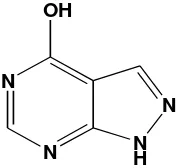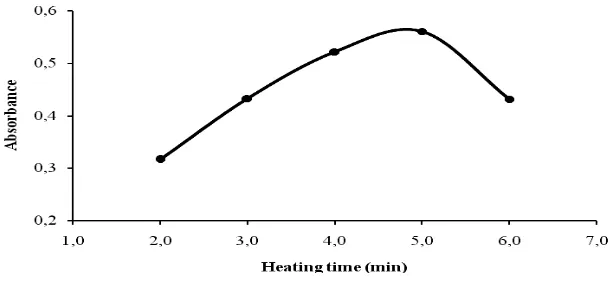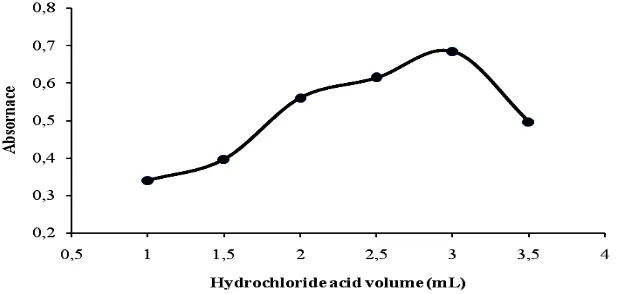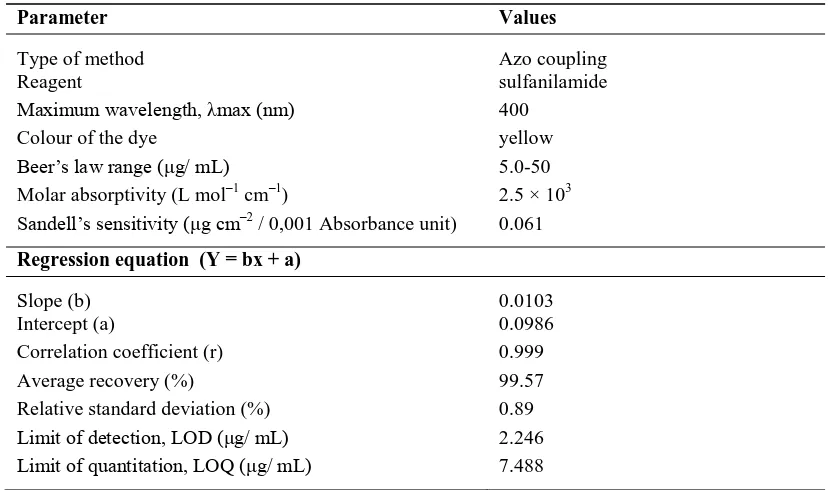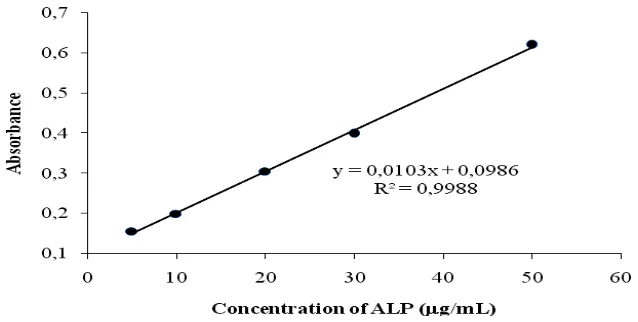DEVELOPMENT OF SPECTROPHOTOMETRIC METHOD
FOR ALLOPURINOL IN URINE BASED ON THE DIAZOTIZATION
REACTION
(Pembangunan Kaedah Spektrofotometrik untuk Penentuan Allopurinol dalam Air Kencing
Berdasarkan Reaksi Diazotisasi)
Edy Agustian Yazid1*, Ganden Supriyanto1,2, Tjitjik Srie Tjahjandarie1
1
Chemistry Depertment, Faculty of Science and Technology,
2
Institute of Tropical Disease, Airlangga University, Surabaya, Indonesia
*Corresponding author: [email protected]
Abstract
A simple, rapid, low cost, accurate and sensitive spectrophotometric method for the determination of allopurinol (ALP) in urine was developed. This method is based on the reaction of diazotized sulfanilamide with ALP as coupling agent in an alkaline medium. The resulting intense yellow dye has a maximum absorption at 400 nm and stable for more than 1 hour. The Beer’s law limits was obeyed over the concentration range of ALP in aqueous medium from 5.0-50 g/mL. The molar absorptivity and
Sandell’s sensitivity were obtained 2.5 × 103
L mol–1 cm–1and 0.061 g cm–2 /0,001 absorbance unit, respectively. The optimum reaction conditions and other analytical parameters have also been investigated. The correlation coefficient (r) was obtained
0.λλλ. LOD and LOQ were found 2.2 g/mL and 7.5 g/ mL, respectively. The percent recovery and relative standard deviation
(RSD) were found 99.18-100.10 % and 0.3-1.3 %, respectively. The proposed method can be applied successfully to assay ALP in urine by standard addition method and can be considered as an alternative method for determination ALP in the urine samples.
Keywords: spectrophotometry, allopurinol, sulfanilamide, diazotization reaction, coupling
Abstrak
Satu kaedah spektrofotometri mudah, cepat, kos efektif, tepat dan sensitif telah dibangunkan untuk penentuan allopurinol (ALP) dalam air kencing. Kaedah ini dibangunkan berdasarkan tindak balas diazotisasi sulfanilamide dengan ALP sebagai ejen gandingan dalam medium beralkali. Pewarna kuning terang yang terhasil mempunyai penyerapan maksimum pada 400 nm dan stabil selama lebih daripada 1 jam. Had hukum Beer dipatuhi pada julat kepekatan ALP dalam medium akueus 5.0-50 g/mL.
Penyerapan molar dan sensitiviti Sandell’s masing-masing diperolehi 2.5 × 103 L mol–1 cm–2 dan 0.061 g cm–2 /0,001 unit
serapan. Keadaan tindak balas optimum dan parameter analisis lain juga telah dikaji. Pekali korelasi (r) telah didapati 0.999. LOD dan LOQ didapati masing-masing 2.2 g/mL dan 7.5 g/mL. Nilai kebolehulangan dan kejituan sisihan piawai relatif (RSD) didapati masing-masing 99.18-100.10% dan 0.3-1.3%. Kaedah yang dicadangkan boleh digunakan dengan jayanya untuk asai ALP dalam air kencing dengan kaedah tambahan piawai dan boleh dianggap sebagai kaedah alternatif untuk penentuan ALP dalam sampel air kencing.
Kata kunci: spektrofotometri, allopurinol, sulfanilamide, reaksi diazotisasi, gandingan
Introduction
213
because it can cause damage to cells, tissues or organs [8, 9] and the underlying pathogenesis of various degenerative diseases such as cancer, hypertension, coronary heart disease, lung disease, diabetes mellitus and premature aging [10].
Fig 1: Chemical structure of allopurinol (C5H4N4O)
Based on the results of the study showed that administration of allopurinol is able to reduce the production of ROS and can prevent tissue damage caused by aerobic exercise [11]. The provision of high dose allopurinol can reduce oxidative stress in vascular tissue and improve endothelial dysfunction [12]. In addition to treating gout allopurinol is potentially used by athletes as a doping substance because allopurinol supplementation can correct endurance athletes and protect them from injury due to oxidative stress [6].
Several methods have been developed for allopurinol analysis, including conventional volumetric titration method [13], spectrophotometry [14], chromatography techniques [4], capillary electrophoresis [15, 16], flow injection technique [17], and anodic polarographic detection [18]. Volumetric methods need large amounts of chemicals and many steps in preparing standard solutions for analysis before the measurement. In the spectrophotometric method developed by Khayoon et al., [14] showed that the application is still limited only for the determination of allopurinol tablet formulation in pharmaceutical preparations. While other methods that have been mentioned quite complicated and requires considerable time and is not always ideal for practical purposes, especially for the analysis of large numbers of samples.
The aim of present work was to develop simple, cheap, rapid, and sensitive spectrophotometric method for determination ALP in biological fluids (urine) based on diazotization coupling reaction with the new reagent sulfanilamide.
Materials and Methods Instruments
Spectral and absorbance measurements were carried out using Shimadzu UV-Visible Recording spectrophotometer UV-1800, with 1 cm matched quartz cells. The pH measurements were performed on pH meter type HANNA HI 96107 pH - Ion meter.
Reagents and solutions
All reagents and chemicals used were of analytical grade and all solutions were prepared from double distilled water. Allopurinol (ALP) was obtained from Sigma-Aldrich (China), sulfanilamide (Merck), sodium nitrite (Merck), sodium hydroxide (Merck), hydrochloric acid (Merck), trychloroacetic acid (Merck). All solutions were stored in a dark colored bottles.
Sulfanilamide (0.3%)
The solution was prepared by dissolving 0.3000 g of sulfanilamide in 75 mL of double distilled water and diluted up to 100 mL with double distilled water.
N
N NH
Sodium nitrite solution (1 %)
The solution was prepared by dissolving 1.0000 g of sodium nitrite in 100 mL double distilled water in volumetric flask.
Hydrochloric acid solution (1.0 N)
The solution was prepared by diluting 8.3 mL of concentrated hydrochloric acid to a 100 mL double distilled water in a volumetric flask.
Sodium hydroxide solution (2.5 M)
This solution was prepared by dissolving 10 g of sodium hydroxide in double distilled water and adding the double distilled water to 100 mL in a volumetric flask. Sodium hydroxide solution (0.1 M) was prepared from 2.5 M stock solution.
Working ALP solution (500 g/mL)
ALP solution (500 g/mL) was prepared by dissolving an accurately amount of ALP in alkaline double distilled water and completed to the mark with double distilled water.
Preparation of callibration curve
Sulfanilamide (0.3%, 3 mL) solution was acidified by the addition of 3.0 mL of 1 M hydrochloric acid, followed by the addition of 5.0 mL of 1% nitrite solution. The solutions were agitated and kept for 3 minutes at room temperature to allow the completion of diazotization reaction. The resulting diazotized product was coupled with an aliquot of standard ALP solutions (5.0-50 g/mL) followed by heating on a boiling-water bath for 5 minutes. The resulting yellow coloured azo dye was diluted to 25 mL with double distilled water and the absorbance was measured at 400 nm against the reagent blank, which gave negligible absorbance at this wavelength.
Determination of ALP in urine
Blank urine sample (1 mL) was spiked with ALP at a concentration level of 5.0-50 g/mL. Then, 1 mL of 10% trichloroacetic acid was added to each sample and vortex for 1 minute and centrifuged for 5 minutes at 4000 rpm. The clear part of this solution was transferred into a test tube for the coupling reaction according to the procedure recommended above.
Results and Discussion Absorption spectra
In this method, sulfanilamide underwent diazotization reactions after treated with sodium nitrite and hydrochloric acid. The solution was frequently shaken to allow the escape of nitrogen. For the diazotization process, sulfanilamide was readily diazotized in acidic medium and that the diazonium cation would then react with a coupling reagent of ALP in alkaline medium to produce yellow coloured azo product. This yellow colour shows maximum absorbance at 400 nm. This wavelength was then used for all measurements. The corresponding reagent blank has practically negligible absorbance at this wavelength.
Optimization of Experimental Conditions
The effect of various parameters on the absorption intensity of the coloured azo dye was investigated, and the reaction conditions were optimized by conducting a series of experiments. The optimum conditions were established by varying one parameter at a time and keeping the others fixed and observing the effect on absorbance of chromogen for the proposed method.
Effect of the order of addition
215
Table 1: Effect of order of reagents addition
Order No. order of addition Absorbance
I S + H + N + A 0.561
II S + N + H + A 0.499
III H + N + S + A 0.423
[S = sulfanilamide; H = hydrochloric acid; N = sodium nitrite; A = allopurinol].
Effect of diazotization time and azo product formation
The effect of time on both reaction steps of diazotization and coupling reaction for maximum formation of the azo dye was investigated by allowing the reaction to proceed for varying times. The diazotization reaction time was found to be completed within 3 minutes as shown in Figure 2. Slow coupling reaction between the diazotized product and ALP was obseved at room temperature. In order to increase the reaction rate, the mixed reagent solution was heated on a boiling-water bath, and heating time was optimized as shown in Figure 3. The azo dye formation developed rapidly after the solution was heated, attained maximum intensity up to 5 minutes. The absorbance was decreased for a longer heating time. Further analyses were performed on 5 minutes heating on a boiling-water bath.
Figure 2: Effect of diazotization time for the formation of maximum azo dye
Effect of sulfanilamide
The effect of different volumes of sulfanilamide on the maximum formation of the azo dye was studied and presented in Figure 4. The results showed that 3.0 ml of 0.3% sulfanilamide is enough to form the diazonium ion and it was used in the subsequent experiments.
Figure 4: Effect of the volume of 0.3 % sulfanilamide solution for the formation of maximum azo dye
Effect of hydrochloric acid
The diazotization reaction occurred in acidic condition. The effect of hydrochloric acid concentration was investigated for maximum diazotization. It was found that the absorbance was increased with increasing acid volume from 1.0-3.0 mL of 1 M hydrochloric acid solution as shown in Figure 5. Above this range, a decrease in absorbance was observed. Thus, 3.0 mL of 1M hydrochloric acid was used in all methods.
Figure 5: Effect of the volume of 1.0 M hydrochloride acid solution for the formation of maximum azo dye
Effect of sodium nitrite
217
sodium nitrite solution with a volume of 5.0 mL. This volume was sufficient for complete diazotization and selected in order to ensure an excess of reagent to guarantee the reaction development.
Figure 6: Effect of the volume of 1% sodium nitrite solution for the formation of maximum azo dye
Stability of the azo dye
The yellow color of azo dye develops instantaneously after the solution was heated on a boiling-water bath and remains stable for more than 1 hour at room temperature. The absorbance measurements are carried out in the subsequent experiments after dilution to mark up immediately.
Table 2: Optical characteristics of proposed method for spectrofotometric determination of ALP
Parameter Values
Type of method Azo coupling
Reagent sulfanilamide
Maximum wavelength, max (nm) 400
Colour of the dye yellow
Beer’s law range ( g/ mL) 5.0-50 Molar absorptivity (L mol–1 cm–1) 2.5 × 103 Sandell’s sensitivity ( g cm–2 / 0,001 Absorbance unit) 0.061 Regression equation (Y = bx + a)
Slope (b) 0.0103
Intercept (a) 0.0986
Correlation coefficient (r) 0.999
Average recovery (%) 99.57
Relative standard deviation (%) 0.89
Analytical performance and calibration curve
Analytical performance carried out on the proposed method reveal satisfactory results. Recovery studies results are close to 100%, which indicates good accuracy of the method. Calibration curve between the absorbance at the maximum wavelength of 400 nm and the concentration of ALP within Beer´s law limits was found linear over the concentration range 5.0-50 g/mL. Regression analysis using method of least squares of the calibration data. The correlation coefficient was found from the linear regression equation r = 0.999, which indicated an excellent linearity (Figure 7). The high molar absorptivities of the resulting colored complex indicate the high sensitivity of the method. The low value of relative standard deviation showing the reproducibility of the proposed methods. Table 2 presents the optical characteristic such as maximum absorption, molar absorptivity, Sandell's sensitivity and others.
Figure 7: Calibration curve of spectrophotometric determination of ALP at 400 nm.
Accuracy and precision of the method
To check the accuracy and precision of the proposed analytical method, ALP is determined at three different concentrations with three replications. The results are shown in Table 3, which indicate good accuracy and precision.
Table 3: Accuracy and precision of the proposed method
ALP given (g/mL)
ALP obtained
(g/mL) SD RSD (%) Recovery (%)
10 9.8 0.21 2.17 98.45
20 20.1 0.32 1.60 100.68
50 50.7 0.92 1.81 101.44
Application of the method
219
Table 4: Accuracy and precision of the proposed method (standard addition method)
Amount of developed. Analysis based on the reaction diazotized of sulfanilamide with ALP as the coupling reagent in alkaline medium to form intense yellow coloured product, which having maximum absorption at 400 nm. The proposed method was successfully applied as an alternative method to assay ALP in urine using standard addition method.
Acknowledgement
The authors are grateful to Analytical laboratory of Chemistry Department of Airlangga University, Surabaya, Indonesia for providing the facilities to carry out this research work.
References
1. Ruiz, T.P., Lozano, C.M., Tomas, V. & Martin, J., (2003). Determination of allopurinol by micelle-stabilised room temperature phosphorescence in real samples. Journal of Pharmaceutical and Biomedical Analysis, 32: 225–231.
2. Amal A. Ammar, A.A., Samy, A.M., Marzouk, M.A., Ahmed, M.K., (2011). Formulation, Characterization And Biopharmaceutical Evaluation Of Allopurinol Tablets, International Journal of Biopharmaceutics, 2(2): 63-71.
3. Sreeram, V., Rao, M.V.B., Karumuri, S.R., (2013), A Validated and Stability Indicating Ultra Performance Liquid Chromatographic Method for Allopurinol in Pharmaceutical Preparation, Paripex-Indian Journal Of Research, 3: 6–10.
4. Reinders, M.K., Nijdam, L.C.,Van-Roon, E.N., Movig, K.L.L., Jansen, T.L.Th.A., Van De Laar, M.A.F.J., Brouwers, J.R.B.J., (2007). A Simple Method for Quantification of Allopurinol and Oxipurinol in Human Serum by High-Performance Liquid Chromatography with UV-Detection, Journal of Pharmaceutical and Biomedical Analysis, 45(2): 312-317.
5. Ali, N.W., Abdelwahab, N.S., EL-fatatry, H.M., and Osman, W.M., (2013). Spectrophotometric Methods for Simultaneous Determination of Two Hypouricemic Drugs in their Combined Dosage Form. Pharm Anal Acta, 4(6): 2-8.
6. Purwanto, B., (2012). Supplementation Allopurinol Pre-Exercise For Athletes Safeguard Against Oxidative Stress, IPTEKOR Journal, 5 (1) : 1 - 11.
7. Chevion, S., Moran, D.S., & Heled, Y., (2003). Serum Antioxidant Stress and Cell Injury After Severe Physicaal Exercise, Proceedings of The United State of America , 100 (9): 5119-5123.
8. Cortina-Puig, M., & Camp, M., (2007). Electrochemical Biosensors as a Tool for Antioxidant Capacity Assessment, J Sens Actua, 129: 459-466.
9. Small, D.M., Coombes, J., Bennett, M., Johnson, D.W., and Gobe, G.C., (2012). Oxidative Stress, Anti-Oxidant Therapies and Chronic Kidney Disease, Asian Pacific Society Of Nephrology 17(4): 311-321.
10. Halliwell. B., Gutteridge J.M.C., (2007). Free Radical in Biology and Medicine, 4th ed, Oxford University Press, New York.
12. George, J., Carr, E., Davies, J., Belch, J.J., Struthers, A., (2009). High-Dose Allopurinol Improves Endothelial Function by Profoundly Reducing Vascular Oxidative Stress and Not by Lowering Uric Acid, Circulation, 114: 2508–2516.
13. Hassib, S.T., Safwat, H.M., and El-Bagry. R.I., (1986). Spectrophotometric Determination of Some Anti-Inflammatory Agents Using N-Bromosuccinimide, Analyst, 111: 45-48.
14. Khayoon, W.S., M.Q. Al-Abaichy, M.Q., Jasim, M, and M.A. Al-Hamadany, M.A., (2008). Spectrophotometric Determination of Allopurinol in Tablet Formulation, Journal. Phys. Sci., 19(2): 23-30. 15. Ruiz, T.P., Lozano, CM., Tomás, V., and Galera, R., (2003). Development of a Capillary Electrophoresis
Method for The Determination of Allopurinol And its Active Metabolite Oxypurinol, Journal Chromat. B, 798: 303–308.
16. Sun, X., Cao, W., Bai, X., Yang, X., Wang, E., (2001). Determination of Allopurinol and its Active Metabolite Oxypurinol by Capillary Electrophoresis with End-Column Amperometric Detection, Analytica Chimica Acta, 121–128.
17. Zen, J.M., Chen, P.Y., and Kumar, A.S., (2002). Flow Injection Analysis of Allopurinol by Enzymeless Approach at Glassy Carbon Electrodes, Electroanalysis, 14 (10): 645-649.
